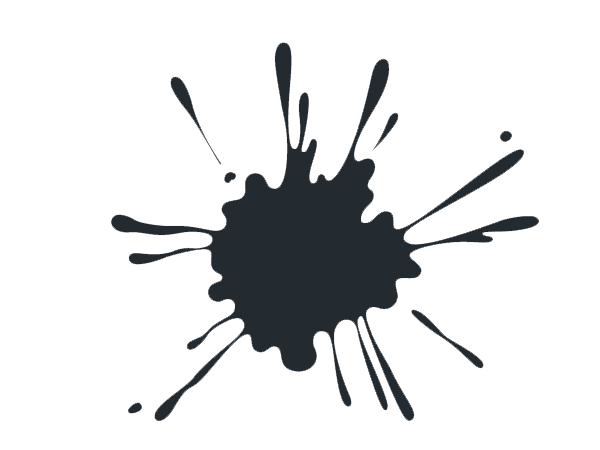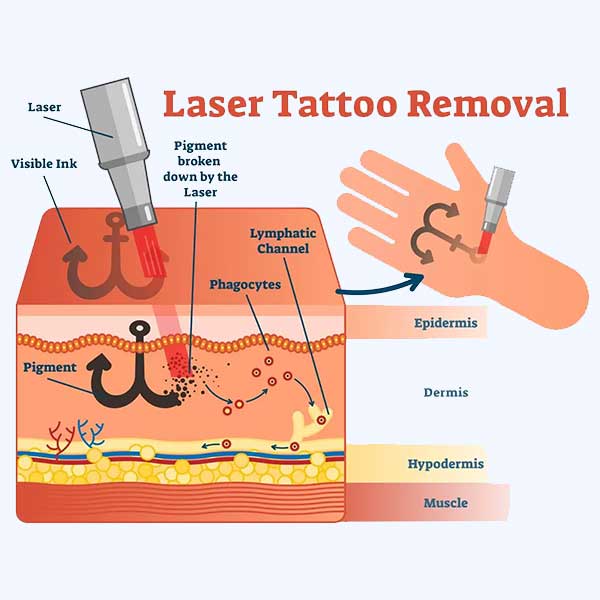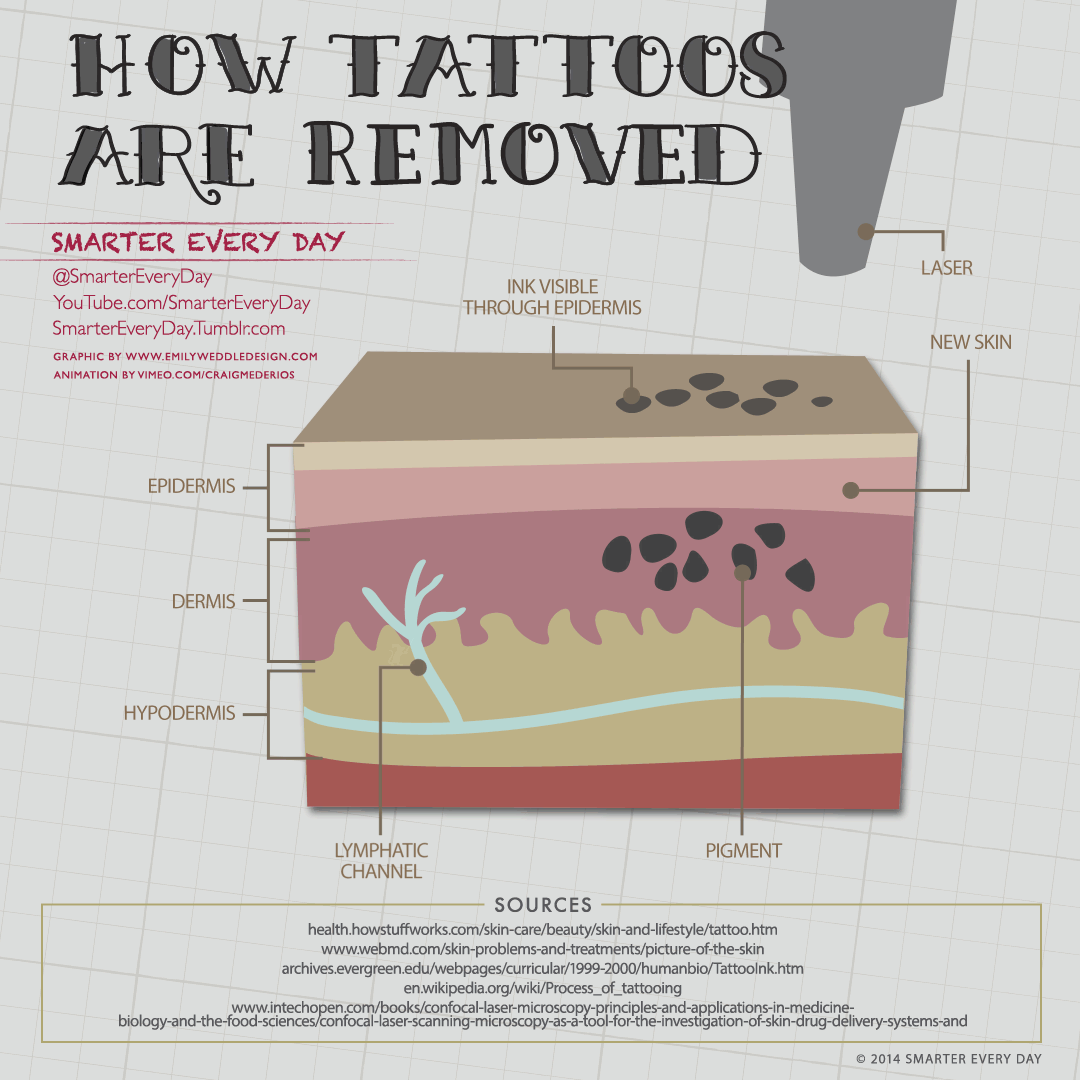We are dedicated to removing your tattoo safely & quickly
How Does Laser Tattoo Removal Work?
It’s a process… but with the right experience and laser it’s very effective
Let’s start from the beginning…
The most common method of tattooing uses an electric tattoo machine which rapidly injects ink into the skin. The body’s immune system attacks the invading ink pigment with macrophages to capture, consume and remove the ink from your system. Some macrophages over-consume and become so full that they can’t move, remaining where they are, and the agglomeration of ink they have consumed is visible through the skin as a tattoo.

The laser breaks up the ink…
Laser tattoo removal works by using lasers to break up the ink particles in the tattoo. The lasers emit short bursts of highly concentrated light, which are absorbed by the ink particles. The energy from the laser causes the ink particles to break up into smaller pieces, which can then be absorbed by the body or eliminated through the body’s natural processes.

You body removes the ink…
After the laser treatment, the broken-up ink particles are absorbed by the body and then eliminated through its natural processes. The body’s immune system plays a role in this process by recognizing the ink particles as foreign substances and working to remove them.
The broken-up ink particles are carried away by the body’s white blood cells, which transport them to the liver. The liver then processes the particles and removes them from the body through the urine or feces. In this way, the body is able to naturally eliminate the ink particles over time.
It’s important to note that complete removal of the tattoo may require multiple treatments, as the laser can only remove a certain amount of ink with each treatment. The number of treatments needed will depend on the size, location, and age of the tattoo, as well as the individual’s skin type and overall health.

It takes time…
The length of time it takes for a tattoo to be completely removed with laser treatments can vary widely. It depends on several factors, including the size, location, and age of the tattoo, as well as the individual’s skin type and overall health.
In general, smaller tattoos will require fewer treatments and will be quicker to remove than larger tattoos. Similarly, tattoos located on areas of the body with thin skin, such as the wrists or ankles, will generally be quicker to remove than tattoos located on thicker areas of skin, such as the back or thighs.
The age of the tattoo is also an important factor. Newer tattoos tend to be easier to remove than older tattoos, as the ink particles will be larger and closer to the surface of the skin. Older tattoos may require more treatments because the ink particles will have had more time to disperse and become more difficult to target with the laser.
On average, it can take anywhere from a few months to several years to completely remove a tattoo with laser treatments. The specific number of treatments needed will depend on the individual tattoo and the factors mentioned above.
Tattoo Removal Frequently Asked Questions
Laser tattoo removal can be uncomfortable and is often described as feeling like a rubber band snapping against the skin. The pain is generally minimal and can be managed with over-the-counter pain medication, such as acetaminophen or ibuprofen. Some people may also find that applying a cold compress to the treated area helps to reduce discomfort. It’s important to keep in mind that everyone’s pain tolerance is different, so the level of discomfort experienced during laser tattoo removal may vary from person to person. If you are concerned about pain, let us know and we can recommend ways to manage any discomfort you may experience.
Also, if you plan to do your first session that same time, we recommend applying a bag of ice to the area for 10-15 minutes. Please keep the ice on the tattoo until just before your treatment in the office. Please let us know if you have any other questions!
The number of laser tattoo removal treatments you will need depends on several factors, including the size, location, age, and color of your tattoo, as well as your skin type and the depth of the ink in your skin. On average, most people need 6-10 treatments to remove a tattoo, but it can take more or fewer treatments depending on these factors. Some tattoos may be more difficult to remove than others, and may require additional treatments. It is also important to note that laser tattoo removal can be a time-consuming and expensive process, so it is important to carefully consider your decision to get a tattoo and to choose a reputable tattoo artist.
The cost of laser tattoo removal can vary depending on the size. On average, the cost can range from $85 to $500 per treatment session, and most people require 6 to 10 sessions. We also offer packages to save even more money. Additionally if your tattoo is being stubborn you don’t have to worry, after your 10th sessions all remaining sessions are 50% OFF
Laser tattoo removal can cause some side effects, but most are temporary and resolve on their own within a few days to a few weeks. Some common side effects include:
- Pain: Laser tattoo removal can be painful, but most people tolerate it well. The pain is often described as a rubber band snapping against the skin. Pain medication can be taken before and after the treatment to help manage discomfort.
- Swelling: Swelling is a common side effect of laser tattoo removal. It is usually mild and goes away on its own within a few days to a week.
- Redness and swelling: The treated area may be red and swollen for a few days after the treatment. This is normal and usually goes away on its own.
- Blistering: Blistering is a common side effect of laser tattoo removal, especially if the tattoo is large or has many colors. The blisters usually heal on their own within a few days to a week.
- Scabbing: The treated area may form a scab after the treatment. It is important to keep the scab moisturized to help with the healing process.
- Hypopigmentation or hyperpigmentation: In some cases, the treated area may lose pigment (hypopigmentation) or gain pigment (hyperpigmentation) after the treatment. These changes are usually temporary, but in some cases, they may be permanent.
- Infection: As with any procedure that breaks the skin, there is a risk of infection. To reduce the risk of infection, it is important to follow the aftercare instructions provided by ReversaTatt.
- Scarring: There is a small risk of scarring after laser tattoo removal. When removing your tattoo, we take extra care to keep your skin looking good in the process. After all whats the point of removing a tattoo to just leave a scar behind. With nearly 100,000 sessions of experience, and using the best equipment in tattoo removal we’ve reduced the risk of scarring to roughly 1% or less.
Yes, most tattoos can be removed using laser tattoo removal techniques. The number of treatments required to remove a tattoo will depend on a number of factors, including the size, color, age, and location of the tattoo, as well as the individual’s skin type and healing characteristics. Some tattoos may be more difficult to remove than others, and may require more treatments to achieve the desired results. The laser works by breaking down the ink particles in the tattoo, which are then absorbed by the body and naturally removed over time. The laser produces short bursts of intense light that are absorbed by the ink particles, causing them to break down into smaller pieces. As the ink particles are broken down, the tattoo gradually fades and becomes less visible.
The length of time it takes to remove a tattoo depends on a number of factors, including the size and location of the tattoo, the colors used in the tattoo, and the individual’s skin type. It can take anywhere from a few weeks to several months or even years to remove a tattoo, depending on these factors. The number of treatments required to remove a tattoo also varies, but it is usually between 6 and 10 sessions. The intervals between treatments are typically spaced about 6 to 8 weeks apart.
During the tattoo removal process, the tattoo ink is broken down and absorbed by the body. The body’s immune system then works to clear the ink from the skin. The laser tattoo removal process is usually done on an outpatient basis, and most people are able to return to their normal activities immediately after the treatment.
It’s important to note that tattoo removal is not always successful, and the tattoo may not be completely removed. Although this is very rare for black ink tattoos. With colors ink tattoos there are some other factors at play such of skin types.
Laser tattoo removal is generally considered safe when performed by a trained and experienced healthcare provider. However, like with any medical procedure, there are some risks and potential side effects that you should be aware of.
The most common side effects of laser tattoo removal include:
- Pain and discomfort during the procedure
- Swelling and redness around the tattoo
- Crusting or scabbing of the skin
- Changes in skin color, including lighter or darker patches around the tattoo
In general, you can expect the treated area to be red, swollen, and possibly blistering or scabbing after a laser tattoo removal treatment. Here are some general aftercare tips:
- Keep the treated area clean: Gently wash the area with soap and water and pat it dry.
- Apply ointment: Use a thin layer of ointment, such as petroleum jelly or an antibiotic ointment, to keep the skin moisturized and protect it from infection.
- Avoid direct sunlight: Keep the treated area out of direct sunlight, and use a high SPF sunscreen if it is exposed to the sun.
- Avoid picking at scabs: Allow any scabs or blisters to heal naturally. Picking at them can cause scarring and increase the risk of infection.
- Use over-the-counter pain medication: If you experience pain or discomfort, you can take over-the-counter pain medication such as acetaminophen (Tylenol) or ibuprofen (Advil).
If you experience any unusual symptoms or have concerns about your healing, be sure to contact us for further guidance.



